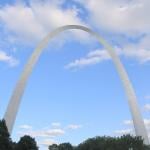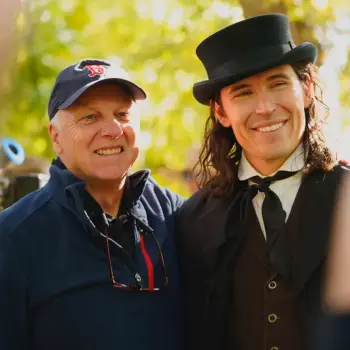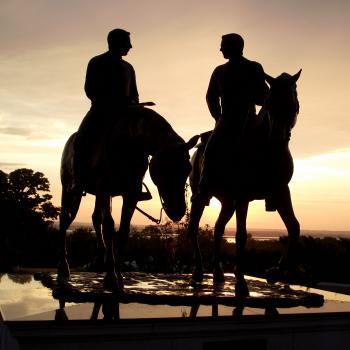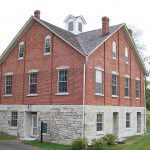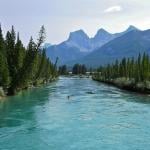
My wife and I headed out this morning, Monday morning, over the Mississippi River and into Illinois, to the Cahokia Mounds, which are both a UNESCO World Heritage Site and an Illinois State Historic Site. I’ve wanted to visit Cahokia for many years but, somehow, we’ve always been in a hurry and unable to spare the time. On this occasion, though, we arrived early for precisely that reason, and we were able to spend much of the morning on the site, especially concentrating on Monks Mound, the largest of the site’s roughly 120 original earthen mounds.
It still wasn’t a fully satisfactory visit. We knew in advance that the visitor center or interpretive center has been closed for roughly two years — one of the construction workers told us that it will likely open again sometime in April, and we needed to pick Camrey Bagley Fox (who played Emma Smith in Witnesses and Six Days in August) and John Donovan Wilson (Brigham Young in Six Days) up at the airport in St. Louis. So we’ll need to return to Cahokia. (I will, in fact, return to it again below.
With Camrey and Johnny onboard, we drove up through Hannibal, Missouri, and by Quincy, Illinois, to Nauvoo. After arriving at Nauvoo, we had to take off again briefly for groceries in Fort Madison, Iowa. (Nauvoo isn’t exactly overstocked, especially at this season of the year, with restaurants and places to buy food.) Finally, though, we’re settled in for the evening. Our filmmakers — Mark Goodman, James Jordan, and Russ Richins — came in on the same flight from Salt Lake City that brought Camrey and Johnny, and they arrived at our hotel while we were over in Fort Madison. The actual work begins early tomorrow morning.
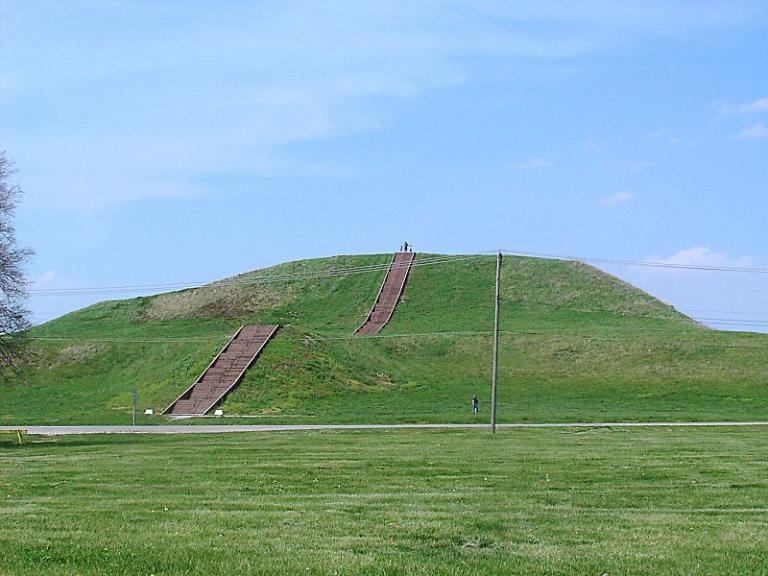
Cahokia is the largest and most complex pre-Columbian site north of Mexico, and the most important center of the so-called Mississippian culture. It may first have been settled around AD 600, and mound building may have begun in the 800s. But it really flourished as a city between about 1050 AD (when it has been described as experiencing a kind of “Big Bang”) and 1350 AD, with a population that may have reached as high as 20,000 — or even, some are evidently now arguing, as high as 40,000. About eighty of the original 120 mounds still survive. The State Park encompasses roughly 3.5 square miles of an urban area that once covered about six square miles.
The original name of the city is lost to history. The toponym Cahokia comes from the name of a tribe that lived in the area when French explorers came in the seventeenth century, but that was several centuries after the site had been abandoned by its original inhabitants, and there is no reason to suppose that the Cahokia people were necessarily related to the builders of the mounds.
If the highest population estimate, given above, is correct, Cahokia was larger than any subsequent city within the borders of the modern United States until the 1780s, when Philadelphia’s population first exceeded 40,000. It was the largest urban center north of the great Mesoamerican cities in Mexico and Central America. At its height, in fact, its population may have been larger than the contemporary European cities of London and Paris.
Cahokia’s location was a strategic one, near the confluence of the Mississippi, Missouri, and Illinois rivers, and it maintained trading links with communities as far away as the Great Lakes to the north and the Gulf Coast to the south. Archaeologists have found evidence of trade in such non-local items as copper, shark teeth, chert from southwestern Illinois, and the shells of lightning whelks (a kind of predatory sea snail).
There is evidence to suggest public ritual human sacrifice was practiced at Cahokia, perhaps especially of women. One mass burial seems to include fifty young women who were all about twenty-one years of age when they died. However, the bodies of several young men have also been found — without heads and hands. In another mass burial, there is evidence of struggle after the victims were buried alive. On the other hand, some powerful leaders were interred in ridge-top mortuary mounds.
In the late 1100s, for reasons that are far from clear or obvious, people began to leave Cahokia. By 1350, it had been abandoned altogether. Our knowledge of its history will likely always be sketchy and based on guesswork, as no writing has come down to us from the people who build it and lived in it. Most likely they didn’t have a system of writing.
One of the more interesting structures at Cahokia was the so-called “Woodhenge,” a series of large timber circles that are located approximately 2790 feet (850 meters) to the west of Monks Mound. They are currently thought to have been constructed between 900 and 1100 AD. They are gone now, but, because decaying organic materials leave signs of their one-time existence behind them in soil, their placement can be identified — and their positions were quite regular. It is thought that they may have served for observation of the Sun and the seasons. In other words, they are being interpreted by the archaeoastronomers who have studied them as calendrical instruments, not unlike Stonehenge itself,
Cahokia is a fascinating place, and it illustrates the fact that we don’t need to travel to Europe or the Middle East to see intriguing historical and religious sights. There are cultural artifacts within the boundaries of the United States that are every bit as exotic as anything to bound elsewhere.
Posted from Nauvoo, Illinois


